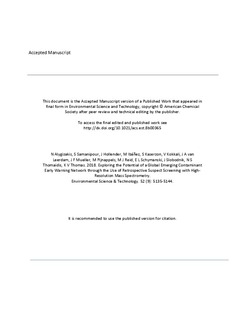| dc.contributor.author | Alygizakis, Nikiforos A | |
| dc.contributor.author | Samanipour, Saer | |
| dc.contributor.author | Hollender, Juliane | |
| dc.contributor.author | Ibáñez, Maria | |
| dc.contributor.author | Kaserzon, Sarit | |
| dc.contributor.author | Kokkali, Varvara | |
| dc.contributor.author | van Leerdam, Jan A | |
| dc.contributor.author | Mueller, Jochen F | |
| dc.contributor.author | Pijnappels, Martijn | |
| dc.contributor.author | Reid, Malcolm J | |
| dc.contributor.author | Schymanski, Emma L | |
| dc.contributor.author | Slobodnik, Jaroslav | |
| dc.contributor.author | Thomaidis, Nikolaos S | |
| dc.contributor.author | Thomas, Kevin V | |
| dc.date.accessioned | 2019-06-03T08:29:24Z | |
| dc.date.available | 2019-06-03T08:29:24Z | |
| dc.date.created | 2019-03-15T00:06:11Z | |
| dc.date.issued | 2018 | |
| dc.identifier.citation | Environmental Science and Technology. 2018, 52 (9), 5135-5144. | nb_NO |
| dc.identifier.issn | 0013-936X | |
| dc.identifier.uri | http://hdl.handle.net/11250/2599634 | |
| dc.description.abstract | A key challenge in the environmental and exposure sciences is to establish experimental evidence of the role of chemical exposure in human and environmental systems. High resolution and accurate tandem mass spectrometry (HRMS) is increasingly being used for the analysis of environmental samples. One lauded benefit of HRMS is the possibility to retrospectively process data for (previously omitted) compounds that has led to the archiving of HRMS data. Archived HRMS data affords the possibility of exploiting historical data to rapidly and effectively establish the temporal and spatial occurrence of newly identified contaminants through retrospective suspect screening. We propose to establish a global emerging contaminant early warning network to rapidly assess the spatial and temporal distribution of contaminants of emerging concern in environmental samples through performing retrospective analysis on HRMS data. The effectiveness of such a network is demonstrated through a pilot study, where eight reference laboratories with available archived HRMS data retrospectively screened data acquired from aqueous environmental samples collected in 14 countries on 3 different continents. The widespread spatial occurrence of several surfactants (e.g., polyethylene glycols (PEGs) and C12AEO-PEGs), transformation products of selected drugs (e.g., gabapentin-lactam, metoprolol-acid, carbamazepine-10-hydroxy, omeprazole-4-hydroxy-sulfide, and 2-benzothiazole-sulfonic-acid), and industrial chemicals (3-nitrobenzenesulfonate and bisphenol-S) was revealed. Obtaining identifications of increased reliability through retrospective suspect screening is challenging, and recommendations for dealing with issues such as broad chromatographic peaks, data acquisition, and sensitivity are provided. | nb_NO |
| dc.language.iso | eng | nb_NO |
| dc.publisher | American Chemical Society | nb_NO |
| dc.title | Exploring the Potential of a Global Emerging Contaminant Early Warning Network through the Use of Retrospective Suspect Screening with High-Resolution Mass Spectrometry | nb_NO |
| dc.type | Journal article | nb_NO |
| dc.type | Peer reviewed | nb_NO |
| dc.description.version | acceptedVersion | nb_NO |
| dc.source.pagenumber | 5135-5144 | nb_NO |
| dc.source.volume | 52 | nb_NO |
| dc.source.journal | Environmental Science and Technology | nb_NO |
| dc.source.issue | 9 | nb_NO |
| dc.identifier.doi | 10.1021/acs.est.8b00365 | |
| dc.identifier.cristin | 1684945 | |
| dc.relation.project | EC/FP7/603437 | nb_NO |
| dc.relation.project | Norges forskningsråd: 243720 | nb_NO |
| cristin.unitcode | 7464,30,21,0 | |
| cristin.unitname | Miljøkjemi | |
| cristin.ispublished | true | |
| cristin.fulltext | postprint | |
| cristin.qualitycode | 2 | |
